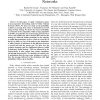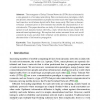TIT
2010
13 years 10 months ago
2010
Abstract--The goal of this paper is to increase our understanding of the fundamental performance limits of mobile and Delay Tolerant Networks (DTNs), where end-to-end multi-hop pat...
WIOPT
2010
IEEE
14 years 1 months ago
2010
IEEE
—In this paper, we apply evolutionary games to non-cooperative forwarding control of Delay Tolerant Networks (DTN). We focus our study on the probability to deliver a message fro...
INFOCOM
2010
IEEE
14 years 1 months ago
2010
IEEE
—Much research has been devoted to maximize the life time of mobile ad-hoc networks. Life time has often been defined as the time elapsed until the first node is out of battery...
CORR
2010
Springer
2010
Springer
Understanding periodicity and regularity of nodal encounters in mobile networks: A spectral analysis
14 years 2 months ago
Abstract--Study on human mobility is gaining increasing attention from the research community with its multiple applications to use in mobile networks, particularly for the purpose...
CONEXT
2007
ACM
14 years 5 months ago
2007
ACM
In Delay Tolerant Networks (DTN), diffusion protocols can benefit from the users’ mobility in order to reach some distant nodes. However, existing protocols like flooding pres...
WCNC
2010
IEEE
14 years 6 months ago
2010
IEEE
Abstract—The development of modern communication technologies fosters human networks (HUNETs)—an information dissemination platform comprised of human-carried wirelessenabled d...
BIOWIRE
2007
Springer
14 years 9 months ago
2007
Springer
The emergence of Delay Tolerant Networks (DTNs) has culminated in a new generation of wireless networking. New communication paradigms, which use dynamic interconnectedness as peop...
ICDCSW
2008
IEEE
14 years 9 months ago
2008
IEEE
Research on delay tolerant networks (DTNs) has brought about a plethora of routing algorithms targeted at networks with different mobility patterns. However, few research works ha...
ICC
2008
IEEE
14 years 9 months ago
2008
IEEE
— Delay Tolerant Networks are increasingly being envisioned for a wide range of applications. Many of these applications need support for quality of service (QoS) differentiation...
GLOBECOM
2008
IEEE
14 years 9 months ago
2008
IEEE
—Intermittently connected mobile networks, also called Delay Tolerant Networks (DTNs), are wireless networks in which at any given time instance, the probability of having a comp...




